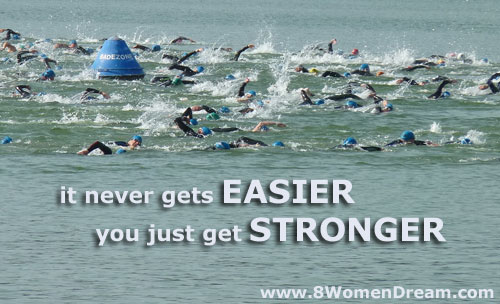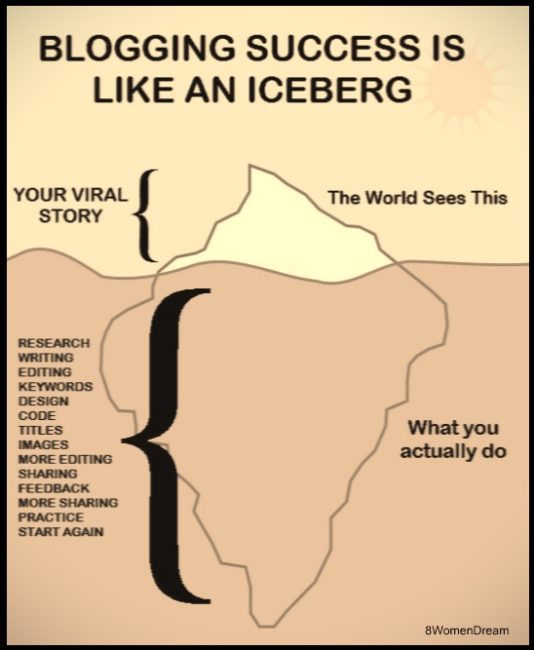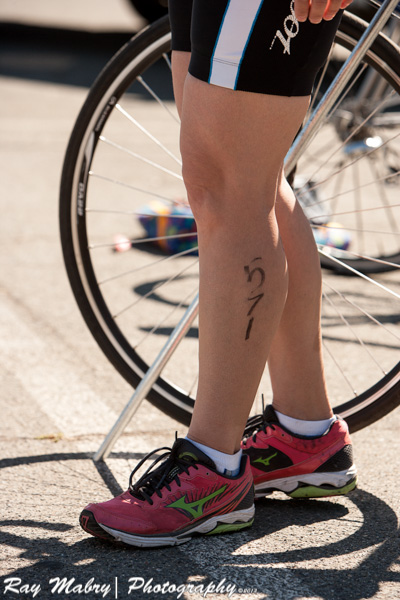How do you know you need dream training?
At some point in your dream, you may pause and ask yourself, “Am I doing this right?”
Doing something the “right” way can save you time, energy, and occasionally, money. Or it can bring up every stubborn bone in your body to stand firm, arms crossed and yell, “I can do this my way!”
In this case, doing it right with dream training saved me from feeling like I was drowning in 3 feet of water.
About a month ago I kicked off the 2nd phase of my triathlon dream by getting back into swimming after years out of the water.
This would be my description of my first lap swimming experience: Gung Ho.
I completely threw myself into getting to the other side of the pool as fast as possible. Just in case you were wondering, this is not the way to learn good swimming skills. One thing I have learned, as your 8 Women Dream health and fitness dreamer, is that there is always more to learn about your big dream.
Dream training instructional video (not included)
It was painfully apparent after my first pool session that I needed to do a bit more research to figure out why I was struggling so hard at swimming. I headed to a few of my favorite beginner triathlon sites to see what others had to say about the swim part of a triathlon.
biggest mistake I made was not practcing in open water
thank god I trained or I would have completely panicked at the starting gun.
I now knew what to avoid. How could I figure out how to manage my swimming practice so I didn’t finish each lap session feeling like I was just drug through mud?
Ask the swim experts
The recurring suggestion on several sites were all the same, pointing me toward this video.
Total Immersion is a foolproof approach to teaching, brings results far faster than conventional methods and helps any student master a fluent, efficient and beautiful technique.
Effortless swimming? It sure looks like hard work when the Olympians are racing, or at the beginning of any triathlon race video. How in the world could this be effortless?
I thought about this video for a week or so, reviewing online sources and snippets of training videos available online. All of them gave me great tips, but I felt like I was missing a big piece of the puzzle. I finally gave in and ordered my own copy of “Total Immersion Swimming: Perpetual Motion Freestyle in Ten Lessons.”
Get in the water
After having the video in the house a few days, I realized I was most likely wasting my time at the pool without practicing good habits. I waited until the house was clear for an hour or so and popped it in.
I wanted to try and absorb (no pun intended) the basics without my family wandering through and asking, “What the heck are you watching?”
Here is a quick preview from one of the Total Immersion DVDs available:
Relax
This goes against all the alarms ringing in my head. Underwater? Can’t breath? Relaxation is not at the thought that pops up first in my mind in this situation.
As I watched the video, I tried to mentally keep track of the several suggested starting points that help you build muscle memory and a good body position in the water, before you even take start swimming. I am obsessive note taker, as writing something down helps me memorize it. Of course. notes are very helpful references when you are halfway through a lap.
Put dream training to work
The next swim day, I slipped in the pool and recalled the initial drills. Thank goodness it was a light day and the slow lanes allowed me to have my own half-lane to swim, otherwise I would have been annoying my fellow pool mates in a hurry.
I ducked under, pushed off and glided. No strokes, no kicking, letting myself sink. This sucked. I could feel myself have a mild panic attack with no forward movement, even with the super-shallow 3′ of water I was in. Standing up, I made myself do it again. This time, not as much panic, and the mantra in my head on repeat: Relax, relax, relax.
Up and down the lane a few times and I was able to just feel the water supporting me. I now knew when I was going to sink and I understood not to struggle to breathe. I did catch that my head was almost always too high to start, and my shoulders wanted to tense up. More of that relaxing in the water practice was definitely needed.
I then tried practicing a few body positions. Down the lane I went — stopping and starting — trying not to tense up or worry about people staring, while trying to keep my neck in alignment. I only swallowed a cup of pool water with these dream training exercises.
Ugh.
I told myself to keep going and after my 3rd pool length things started coming together. I turned just about 45 degrees — just enough for my right shoulder to come up out of the water, but when I’d try this on my left side I’d roll around like a toddler. This continued up the lane and back down the lane.
I glanced at the giant session clock on the wall next to the pool. Time flies when you are attempting to learn something new under a countdown. I had been in the pool 15 minutes with nothing even resembling a “workout” under my belt. The stress started to hit me so I allowed myself to do one lap in freestyle to see how it felt.
Hey! I didn’t feel like I was going to drown! Breathing was so much easier when I moved with my body rotation — instead of fighting to lift my head.
Working too hard is a common downfall for new lap swimmers and I succumbed to it for a few laps before that “relax” mantra kicked in. Once I did this I had much better results and I finished with energy.
Much more in so little time
I’ve continued to watch the video, focusing on just a few lessons at a time that I will take to my next pool session.
In this short time I’ve been able to increase my swim from a struggling, exhausting 600 yards in 30 minutes, to a much more relaxed 1200+ yards in 30 minutes. It’s definitely an improvement.
We have to be patient with ourselves when we are trying to take our dreams to the next level. Think of it as your dream-in-training, and relax.
Just remember: It never gets easier, you just get stronger.
What dream training have you resisted?
Have a healthy, dream relaxing week!
– Heather

Heather Montgomery is a fitness writer, triathlete, and serial entrepreneur who is devoted to sharing what she has learned about becoming a triathlete after age 40. She uses her Metabolic Training Certification to help other women struggling to get fit in mid-life. She lives and trains in Santa Rosa, California, the new home of the Ironman triathlon. You can find her biking the Sonoma County wine trails.
Note: Articles by Heather may contain affiliate links and will be compensated if you make a purchase after clicking on an affiliate link.






